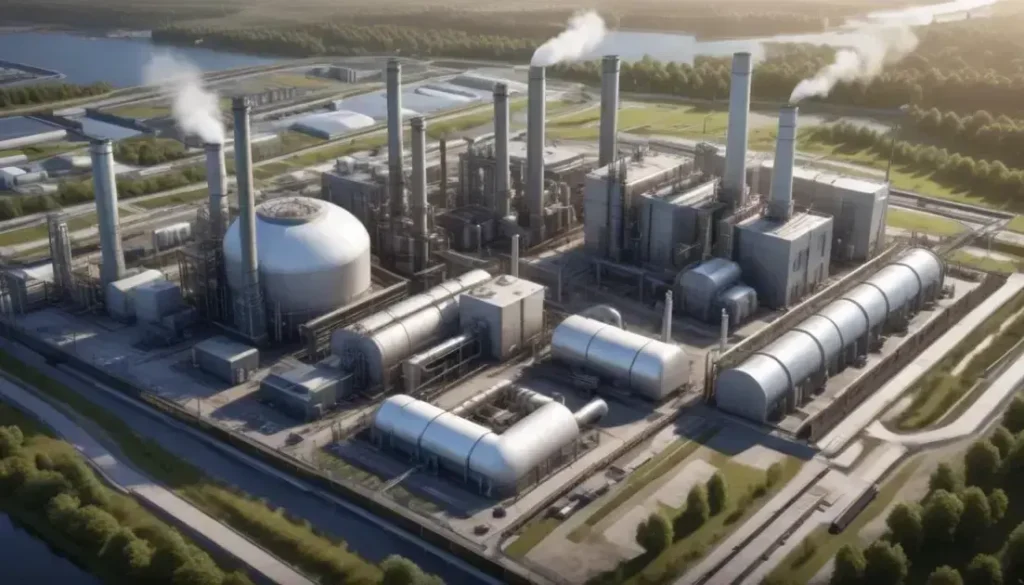Liquid cooling technology enhances data center efficiency by using liquids to effectively manage heat, reducing energy consumption while promoting sustainability and operational longevity.
Liquid cooling is reshaping the landscape of data centres, enabling higher efficiency and lower emissions. Are you curious about how this technology impacts business operations?
Overview of Liquid Cooling Technology
Liquid cooling technology is becoming a game-changer in the world of data centers. This method utilizes liquids, often water or specialized coolant, to effectively remove heat from computing components. Unlike traditional air cooling, liquid cooling offers superior thermal management, enabling systems to run at optimal temperatures while consuming less energy.
The primary advantage of liquid cooling is its efficiency. It can transfer heat away from components much faster than air, making it particularly beneficial for high-performance computing and large-scale data centers. By lowering the thermal resistance, systems can achieve higher densities, allowing for more servers in a given space without overheating.
As businesses face rising energy costs and environmental concerns, liquid cooling presents a sustainable solution. Companies utilizing this technology can reduce power consumption significantly, contributing to greener operations. The adoption of liquid cooling is not just a trend; it’s a strategic move towards energy efficiency, cost savings, and improved performance.
Moreover, advancements in liquid cooling solutions are paving the way for innovations in hardware design. New cooling systems are being developed that integrate seamlessly with existing architectures, ensuring that businesses can upgrade their operations without overhauling their infrastructure.
Impact on AI and High-Performance Computing
Liquid cooling technology plays a vital role in enhancing AI and high-performance computing (HPC). As the demand for processing power grows, so does the need for efficient cooling solutions. Traditional air cooling methods often struggle to keep up with the heat output of advanced processors used in AI and HPC applications.
By utilizing liquid cooling systems, facilities can maintain optimal operating temperatures, leading to superior performance and reliability. Liquid cooling dissipates heat more effectively than air, enabling processors to run at higher speeds without the risk of overheating.
The integration of liquid cooling in AI infrastructures can lead to significant improvements in energy efficiency. This is crucial in cost-sensitive environments, where excessive cooling costs can impact overall operational budgets. Moreover, as AI models become more complex, the ability to run multiple high-performance tasks simultaneously necessitates robust thermal management.
Furthermore, liquid cooling helps in achieving better energy efficiency ratings for data centers. As companies strive for sustainability targets, incorporating advanced cooling solutions aligns with their green initiatives. Reducing energy consumption not only lowers operational costs but also minimizes the carbon footprint.
Sustainability Benefits of Liquid Cooling
Sustainability benefits of liquid cooling are becoming increasingly important as concerns about energy consumption and environmental impact rise. Traditional air cooling systems often require significant energy to maintain optimal temperatures in data centers. In contrast, liquid cooling solutions provide a more energy-efficient alternative.
By using liquids to dissipate heat, these systems consume less energy compared to their air-based counterparts. This results in lower electricity bills for companies and reduces the carbon footprint associated with cooling data centers. Consequently, businesses can enhance their sustainable practices, aligning with global efforts to combat climate change.
Moreover, liquid cooling can extend the lifespan of hardware. Maintaining lower operating temperatures helps reduce wear and tear on servers, leading to less frequent replacements and fewer electronic waste per year. This operational efficiency not only fosters sustainability but also promotes cost savings.
Many companies are adopting liquid cooling as part of their green initiatives. By optimizing energy usage and reducing waste, they can demonstrate their commitment to environmental responsibility. Embracing such innovative technologies is essential for organizations aiming for sustainability in fast-evolving industries.
Global Switch’s Role in Data Centre Innovation
Global Switch has emerged as a leader in data center innovation by integrating advanced technologies and sustainable practices. Their commitment to enhancing operational efficiency has transformed how data centers operate, making them more resilient and environmentally friendly.
One of the key innovations from Global Switch is the implementation of liquid cooling systems. This technology allows data centers to manage heat effectively while significantly reducing energy consumption. By adopting such cutting-edge solutions, Global Switch demonstrates its dedication to sustainability and performance.
The company also invests heavily in scaling its infrastructure to meet the growing demands of cloud services and high-performance computing. By providing scalable solutions, Global Switch supports businesses in adapting to rapid technological changes while maintaining operational efficiency.
Furthermore, Global Switch places a strong emphasis on safety and security, ensuring that their data centers are equipped with the latest security measures. This commitment helps protect valuable data while ensuring compliance with international standards. Overall, Global Switch’s role in innovating data center technologies positions it as a key player in the industry, paving the way for future advancements in data management and sustainability.
Case Studies of Liquid Cooling in Practice
Numerous case studies highlight the practical applications of liquid cooling technology in diverse industries. One notable example is a major cloud service provider that implemented liquid cooling in its data centers to enhance energy efficiency. By switching from traditional air cooling to liquid cooling, the company achieved a remarkable 30% reduction in energy consumption while maintaining performance.
Another case study involves a financial institution that relies heavily on high-performance computing for real-time data processing. The institution faced challenges with heat management and decided to integrate liquid cooling solutions. This transition not only resolved overheating issues but also allowed the institution to house more servers in a limited space, leading to improved operational efficiency.
A third example can be observed in a healthcare organization utilizing liquid cooling to support its research facilities. The ability to keep critical laboratory equipment at optimal temperatures proved vital for experimental accuracy and reliability. By adopting liquid cooling, the organization enhanced its research productivity while contributing to its sustainability goals.
These case studies demonstrate the versatility and effectiveness of liquid cooling systems across various sectors, highlighting their potential to transform data center operations while promoting sustainable practices.
Future Projections for Data Centres in the US
Future projections for data centers in the US indicate a significant shift towards sustainability and technological advancement. As demands for cloud computing and data storage continue to rise, businesses are increasingly adopting energy-efficient strategies to manage operational costs and environmental impact.
One key trend is the integration of renewable energy sources in powering data centers. Many companies are investing in solar and wind energy to reduce their dependency on fossil fuels. This transition not only aligns with global sustainability goals but also positions businesses as leaders in environmentally responsible practices.
Moreover, advancements in liquid cooling technology are set to revolutionize how data centers operate. These systems enable high-density computing environments while minimizing energy consumption. As technology evolves, we can expect more innovations that will enhance cooling efficiency and reduce heat management challenges.
Additionally, artificial intelligence will play a crucial role in optimizing data center operations. AI-driven solutions can predict workloads and manage resources dynamically, leading to greater efficiency and reduced downtime. The combination of these technologies will redefine the landscape of data centers in the US, making them more resilient, efficient, and sustainable for the future.
Conclusion: Embracing Sustainability in Tech
Embracing sustainability in technology is no longer a choice but a necessity for businesses. As the environmental impact of tech companies comes under scrutiny, the shift toward eco-friendly practices is gaining momentum. Companies are recognizing the importance of integrating sustainable methods into their operations to meet regulatory requirements and consumer expectations.
One key area of focus is the reduction of energy consumption in data centers. Implementing energy-efficient technologies, such as liquid cooling systems, helps companies not only minimize costs but also lower their carbon footprints. As a result, sustainability becomes a core aspect of operational strategy.
Furthermore, promoting the use of renewable energy sources enhances a company’s commitment to environmental responsibility. Investing in solar and wind energy solutions showcases a proactive approach to sustainability, which can significantly enhance corporate reputation.
Ultimately, businesses that prioritize sustainability in tech will not only achieve competitive advantages but also contribute positively to global environmental goals. The future of technology lies in balancing innovation with ecological responsibility, making sustainability a guiding principle for all tech developments.
In Conclusion: The Path to a Sustainable Future
Adopting sustainable practices in technology is crucial for the future of our planet. As businesses embrace eco-friendly solutions, they not only help protect the environment but also gain a competitive edge in their industries. Technologies like liquid cooling and renewable energy sources illustrate the commitment to sustainability that many companies are making today.
By prioritizing energy efficiency and reducing carbon footprints, companies can create a positive impact while ensuring long-term success. This commitment to sustainability enhances their reputation and appeals to environmentally conscious consumers.
As we move forward, integrating sustainable practices will remain essential for the tech industry. It is a step towards creating a healthier planet and a brighter future for all.
Frequently Asked Questions
What is liquid cooling technology?
Liquid cooling technology uses liquids to absorb and transfer heat away from computer components, making it more efficient than traditional air cooling.
How does liquid cooling benefit data centers?
Liquid cooling helps data centers operate at optimal temperatures, reducing energy consumption and improving hardware longevity.
What are the sustainability benefits of using renewable energy in data centers?
Using renewable energy lowers carbon footprints, reduces operational costs, and aligns businesses with global sustainability goals.
How can companies implement energy-efficient practices?
Companies can implement energy-efficient practices by investing in technologies like liquid cooling and using renewable energy sources to power their operations.
Why should businesses focus on sustainability in tech?
Focusing on sustainability enhances a company’s reputation, meets consumer demand for eco-friendly practices, and can lead to cost savings in the long run.
What trends will shape the future of data centers?
Trends such as the integration of renewable energy, advanced cooling technologies, and AI-driven management will shape the future of data centers.


